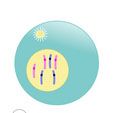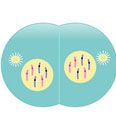![]()
![]()
![]()
Use LEFT and RIGHT arrow keys to navigate between flashcards;
Use UP and DOWN arrow keys to flip the card;
H to show hint;
A reads text to speech;
20 Cards in this Set
- Front
- Back

|
Interphase This is the period where DNA is replicated and growth occurs |
|

|
Prophase This is the period where the nuclear membrane is broken down and Centrioles begin to migrate to the poles (opposite sides) of the cell. Chromatin begins winding tightly to form chromosomes Spindle fibers are being formed |
|

|
Prometaphase (Late Stage Prophase) The spindle fibers attach to the chromosomes, but are not yet aligned. |
|

|
Metaphase The chromosomes are signed up along the center |
|

|
Anaphase The spindle fibers begin pulling the sister chromatids apart (chromatids are each half of the chromosome)The spindle fibers pull by shortening |
|

|
Telophase. Nucleus envelopes begin to reassemble around the two daughter nuclei and the chromosomes unwind back into chromatin. Spindle fibers disappear |
|
|
Cytoplasmic Division |
Starts in Anaphase and continues through Telophase. A contractile ring of Actin apportions organelles and cell contents and begins squeezing the cell apart. |
|
|
What causes Tumors? |
Loss of control of the cell cycle. Tumors are unregulated growth of cells |
|
|
What are benign tumors? |
A tumor that stays in one place and interferes with functions of cells around it by displacing them |
|
|
What are malignant tumors? |
Cancerous tumors that spread throughout the body (this is called metastasis) |
|
|
Oncogenes |
Active other genes to increase cell division |
|
|
Tumor Suppressor Genes |
Stop or slow mitosis. When this is inactivated or missing there is an increase in cell division |
|
|
What are Totipotent cells? |
Stem cells that can become any other cell type |
|
|
What are Pluripotent Cells? |
Stem cells that can be several different cell types, but not all |
|
|
What are stem cells? |
Cells that retain the ability to divide repeatedly to produce new undifferentiated / unspecialized cells. |
|
|
What are Progenitor cells? |
The daughter cell which is specialized but not terminally differentiated. |
|
|
What does terminally differentiated mean? |
A terminally differentiated cell is one that is specialized and will never become another type of cell. For instance, a red blood cell is terminally differentiated, but a hematocytoblast is a progenitor cell (it is specialized, but will become something else) |
|
|
What is Apoptosis? |
Programmed cell death. This occurs when cells are worn out or if the body realizes they are precancerous. |
|
|
What Internal Cues Control Cell Division? |
Telomeres: nucleotides (TTAGGG) that repeat at the tips of chromosomes Levels of kinases and cyclins in the cell cell size (surface area:volume ratio) |
|
|
What External Cues control Cell Division? |
Hormones: Growth Hormone, Thyroxin, Testosterone, Estrogen Growth Factors: Stimulate mitosis but are more locally produced than hormones Available space: When cellular space is inhibited they slow down mitosis |

